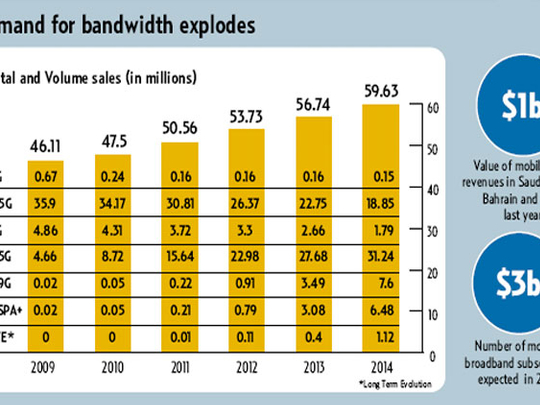
Dubai: At first glance, LTE seems to be just another acronym in a telecom industry that is already awash with them.
But those who have more than a passing acquaintance with the mobile tel-ephony platform believe it will be the ideal building block for the region's telecom sector to go into 4G mode.
In its barest form, LTE, which stands for Long Term Evolution, is expected to bring about vastly improved cost reduction, improved customer experience and evolution to a unified platform for seamless coverage and roaming. In fact, the technology platform is already getting an airing through trials in select regional markets.
"We are seeing phenomenal throughput (data speeds) coming through in one of the trials that we are doing in Saudi Arabia," said Ray Hassan, President and Head of Customer Unit GCC, Ericsson Region Middle East.
"In fact, Ericsson's was the fastest of all LTE equipment trials handled by the operators there."
According to Pyramid Research, Saudi Arabia, Bahrain and the UAE will pioneer LTE adoption in the Middle East as penetration rates for these countries are expected to reach 11.8 per cent by 2014, more than the projected Western European average of 7.7 per cent. The overall regional penetration rate for LTE is expected to be 6.1 per cent by then.
"While the Middle East is a smaller market, it makes up the difference in its potential for growth," said Kerem Arsal, an analyst at Pyramid Research. "The mobile data revenue growth of 34 per cent for 2009 compares with only seven per cent in Western Europe."
Revenues soar
Mobile data revenues in Saudi Arabia, Bahrain and the UAE soared to around $1 billion (Dh3.7 billion) last year, and there is no way the growth rates will slow down at any time in the near term.
Across the Gulf, the absence of a widespread fixed broadband infrastructure forced most subscribers to rely on mobile technologies for their Internet needs. As a result, some of them have experienced a huge rise in mobile broadband demand.
These represent the most suitable nurturing ground for LTE adoption, which is likely to begin its life cycle with data cards and connectivity modems. In addition, the Gulf telcos have already developed much expertise in upgraded 3G networks. This will smooth the transition to LTE.
"LTE is the future and ultimate choice for operators due to the distinct advantages in comparison to other wireless technologies in the market place," said Zheng Xiang, Vice-President for Huawei Middle East.
In 2010, Huawei developed pre-commercial LTE trials with etisalat in the UAE and for Saudi Telecom Company and Zain in Saudi Arabia.
"In the Middle East, the use of data services and demand for bandwidth are exploding among subscribers, driven primarily by smartphones," said Xiang. "New video and Internet-based devices attract immense traffic to networks.
"We forecast the number of mobile broadband subscribers to increase ten-fold, reaching three billion in the next five years."
Informa Telecoms and Media forecasts that by 2014 3.5G+ technologies, including LTE, will be the single largest technology segment of the Middle East mobile market, accounting for 41 per cent of subscriptions.
But LTE has a fight on its hands when it comes to being recognised as the platform of choice for 4G. There is WiMax to contend with.
In its favour, it must be said that WiMax is a tried and tested standard and addresses all the needs for some of the operators by providing Internet and data services.
LTE provides compatibility with the plethora of networks running on GSM, WCDMA, HSPA or CDMA network. It can also help the operator in leveraging its existing 2G/3G infrastructure to maximum potential.
This means users can roam seamlessly under the umbrella of different wireless technologies. But for Hassan, the choice is clear cut. "We view LTE as the undisputed choice," he said. "Most countries and most operators, and certainly many of the equipment vendors, have moved away from WiMax even when they are conducting trials with commercial launches. Also, there are trials beginning to build LTE networks. Other equipment vendors announced that they are moving towards LTE and away from WiMax. WiMax was good in the past, but now it is far surpassed. That is the reason why most operators are moving very quickly to HSPA and LTE." And with deploying LTE becoming more price competitive, WiMax time as a serious contender might be over. "We do expect it to be wiped out, (but) it won't happen immediately," Hassan added. "It is not like turning on a light-switch. But in the next few quarters we expect that most of the operators in the region will move to LTE.
"We view LTE as the undisputed choice. Most countries and most operators and certainly many of the equipment vendors have moved away from WiMax even when they are conducting trials with commercial launches. Also, there are trials beginning to build LTE networks. Other equipment vendors announced that they are moving towards LTE and away from WiMax. WiMax was good in the past, but now it is far surpassed. That is the reason why most operators are moving very quickly to HSPA and LTE."
What is LTE?
Long Term Evolution is the trademarked project name of a high performance air interface for cellular mobile telephony. It is a step toward the fourth generation of radio technologies designed to increase the capacity and speed of mobile telephone networks.
Where the current generation of mobile telecommunication networks are collectively known as 3G (third generation), LTE is marketed as 4G.
Ideally, LTE is a 3.9G technology since it does not fully comply with the 4G requirements.
The LTE specification provides downlink peak rates of at least 100 Mbps, an uplink of at least 50 Mbps LTE supports scalable carrier bandwidths, from 1.4 MHz to 20 MHz and supports both frequency division duplexing (FDD) and time division duplexing (TDD).
The main advantages with LTE are high throughput, low latency, plug and play, FDD and HDD in the same platform, an improved end-user experience and a simple architecture resulting in low operating costs. LTE will also support seamless passing to cell towers with older network technology.
— N.K.C.











